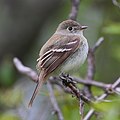Eastern wood pewee
| Eastern wood pewee | |
|---|---|

| |
| In Central Park, New York, USA | |
| Song recorded in Ontario, Canada | |
| Scientific classification | |
| Domain: | Eukaryota |
| Kingdom: | Animalia |
| Phylum: | Chordata |
| Class: | Aves |
| Order: | Passeriformes |
| Family: | Tyrannidae |
| Genus: | Contopus |
| Species: | C. virens
|
| Binomial name | |
| Contopus virens (Linnaeus, 1766)
| |

| |
| Synonyms | |
|
Muscicapa virens Linnaeus, 1766 | |
The eastern wood pewee (Contopus virens) is a small tyrant flycatcher from North America. This bird and the western wood pewee (C. sordidulus) were formerly considered a single species. The two species are virtually identical in appearance, and can be distinguished most easily by their calls.
Taxonomy
In 1760, the French zoologist
Description

The eastern wood pewee is 13.5–15 cm (5.3–5.9 in) in length and weighs around 14 g (0.49 oz).
Similar species
The
The eastern phoebe (Sayornis phoebe) is similar, particularly in the worn plumage after breeding. It always lacks clearly defined wingbars, however, and bobs its tail frequently. It has a shorter primary projection. The eastern phoebe is also present on the breeding grounds by March, while eastern wood pewees do not arrive until very late April and early May.[11] The songs (fee-bee, fee-bee) and calls (chip) are quite different. The least flycatcher (Empidonax minimus) is quite similar to the eastern wood pewee in plumage, but has a bold eye ring and much shorter primary projection, appearing rather blunt-winged. It also has a shorter bill and is smaller overall. The songs (che-bec, che-bec) and calls (a sharp whit) are very different.
-
Eastern wood pewee has two crisp, pale wing bars and long primary projection.
-
sister species.
-
Eastern phoebe lacks bolder wing bars and has shorter primary projection.
-
Least flycatcher has bold eye-rings and shorter primary projection.
Distribution and habitat
Their breeding
Eastern wood pewees arrive relatively late on breeding grounds (e.g., 18 May to 5 June in southern Ontario). They are rarely seen on their breeding grounds before the last days of April further south. They migrate south at a more usual time, leaving sometimes in late August but most often in September. Migration times have stayed the same in the last 100 years. They migrate quickly for most of the journey, dispersing and moving at a slower speed when approaching breeding or wintering range. For example, in the Cayman Islands which are offshore the winter quarters, the species is only rarely and briefly encountered, but passes through on its way north as early as mid-late February.[11][12][13]
Behaviour
Breeding
The eastern wood pewee makes an open
The eggs hatch in 12–14 days and both parents bring food to the
Conservation status
The eastern wood pewee is common and widespread, and therefore not considered globally threatened by the
References
- ^ . Retrieved 12 November 2021.
- ^ Brisson, Mathurin Jacques (1760). Ornithologie, ou, Méthode contenant la division des oiseaux en ordres, sections, genres, especes & leurs variétés (in French and Latin). Vol. 2. Paris: Jean-Baptiste Bauche. pp. 368–370.
- ^ hdl:2246/678.
- ^ Linnaeus, Carl (1766). Systema naturae : per regna tria natura, secundum classes, ordines, genera, species, cum characteribus, differentiis, synonymis, locis (in Latin). Vol. 1, Part 1 (12th ed.). Holmiae (Stockholm): Laurentii Salvii. p. 327.
- ^ Jobling, J.A. (2018). del Hoyo, J.; Elliott, A.; Sargatal, J.; Christie, D.A.; de Juana, E. (eds.). "Key to Scientific Names in Ornithology". Handbook of the Birds of the World Alive. Lynx Edicions. Retrieved 1 July 2018.
- ^ Cabanis, Jean (1855). "Contopus virens Cab". Journal für Ornithologie (in German). 3 (18): 479.
- ^ Gill, Frank; Donsker, David, eds. (2018). "Tyrant flycatchers". World Bird List Version 8.2. International Ornithologists' Union. Retrieved 1 July 2018.
- ^ Farnsworth, A.; Lebbin, D. (2018). del Hoyo, J.; Elliott, A.; Sargatal, J.; Christie, D. A.; de Juana, E. (eds.). "Eastern Wood-pewee (Contopus virens)". Handbook of the Birds of the World Alive. Lynx Edicions. Retrieved 1 July 2018.
- ^ "Eastern Wood-Pewee Identification, All About Birds, Cornell Lab of Ornithology". www.allaboutbirds.org. Retrieved 2020-09-27.
- S2CID 45095086.
- ^ a b Ohio Ornithological Society (2004): Annotated Ohio state checklist Archived July 18, 2004, at the Wayback Machine.
- Wilson Bull.18 (2): 47–60.
- ^ Olson, Storrs L.; James, Helen F.; Meister, Charles A. (1981). "Winter field notes and specimen weights of Cayman Island Birds" (PDF). Bulletin of the British Ornithologists' Club. 101 (3): 339–346. Archived from the original (PDF) on 2012-02-27. Retrieved 2009-10-31.
External links
- Eastern wood pewee – Contopus virens – USGS Patuxent Bird Identification InfoCenter
- Species account – Cornell Lab of Ornithology
- Bird sound - Florida Museum of Natural History
- Eastern wood pewee, Familiar Birds
- Range in Canada - Canadian Biodiversity website
- Eastern wood pewee, Environment Canada
- Explore Species: Eastern Wood-Pewee at eBird (Cornell Lab of Ornithology)
- Eastern wood pewee photo gallery at VIREO (Drexel University)
- Interactive range map of Contopus virens at IUCN Red List maps





